OLDSMOBILE BRAVADA 1996 Repair Manual
Manufacturer: OLDSMOBILE, Model Year: 1996, Model line: BRAVADA, Model: OLDSMOBILE BRAVADA 1996Pages: 340, PDF Size: 17.49 MB
Page 61 of 340
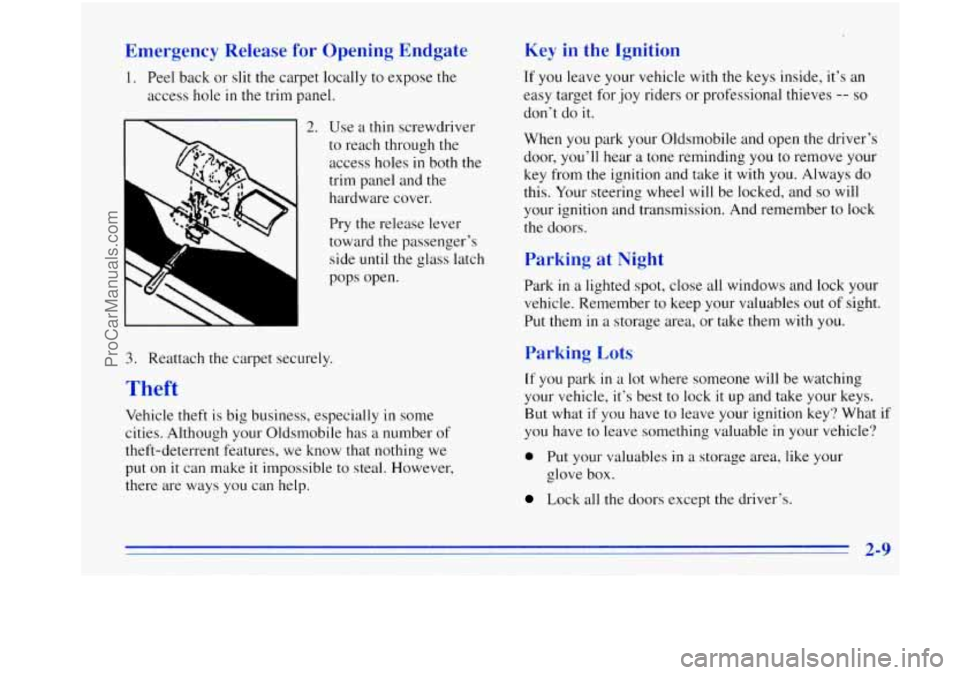
Emergency Release for Opening Endgate
1. Peel back or slit the carpet locally to expose the
access hole in the trim panel.
2. Use a thin screwdriver
Lâ
to reach through the
access holes in both the
trim
ane el and the 1
hardware cover.
3. Reattach the carpet securely. Pry the release
lever
toward the passengerâs
side
until the glass latch
pops open.
Theft
Vehicle theft is big business, especially in some
cities. Although your Oldsmobile has
a number of
theft-deterrent features, we know that nothing we
put
on it can make it impossible to steal. However,
there are ways you can help.
Key in the Ignition
If you leave your vehicle with the keys inside, itâs an
easy target for joy riders or professional thieves
-- so
donât do it.
When
you park your Oldsmobile and open the driverâs
door, youâll hear a tone reminding
you to remove your
key from the ignition and take
it with you. Always do
this. Your steering wheel will be locked, and
so will
your ignition and transmission. And remember to lock
the doors.
Parking at Night
Park in a lighted spot, close all windows and lock your
vehicle. Remember to keep your valuables out
of sight.
Put them in a storage area, or take them with you.
Parking Lots
If you park in a lot where someone will be watching
your vehicle, itâs best to lock it up and take your keys.
But what if
you have to leave your ignition key? What if
you have to leave something valuable
in your vehicle?
0 Put your valuables in a storage area, like your
glove box.
Lock all the doors except the driverâs.
ProCarManuals.com
Page 62 of 340
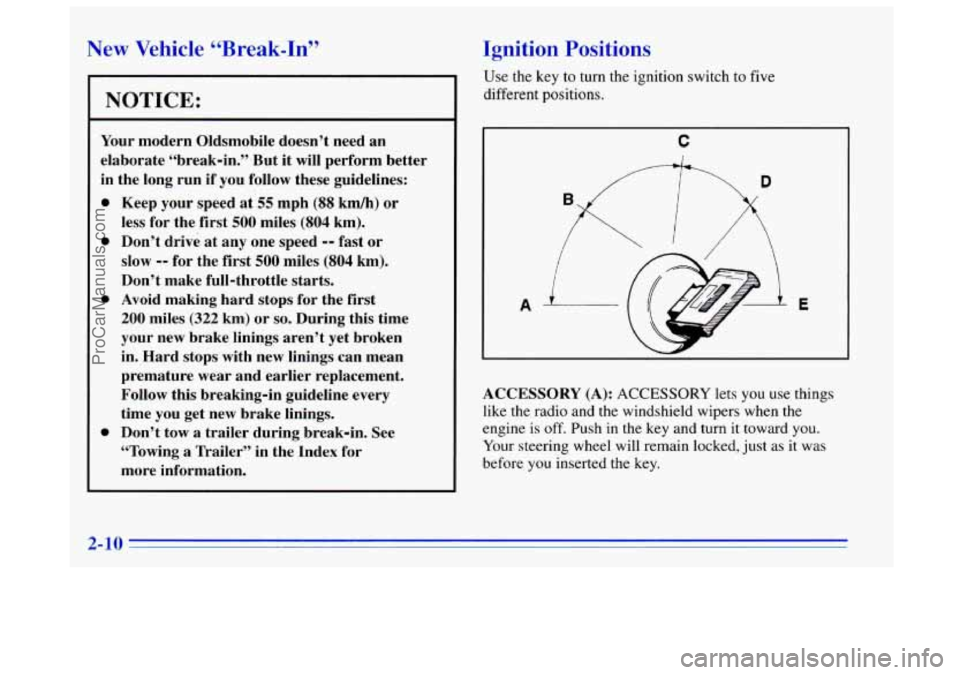
New Vehicle LLBreak-Inâ
NOTICE:
Your modern Oldsmobile doesnât need an
elaborate âbreak-in.â But it will perform better
in the long run if you follow these guidelines:
a
0
0
0
Keep your speed at 55 mph (88 kmh) or
less for the first
500 miles (804 km).
Donât drive at any one speed
-- fast or
slow
-- for the first 500 miles (804 km).
Donât make full-throttle starts.
Avoid making hard stops for the first
200 miles (322 km) or so. During this time
your new brake linings arenât yet broken
in. Hard stops with new linings can mean
premature wear and earlier replacement.
Follow this breaking-in guideline every
time you get new brake linings.
Donât tow
a trailer during break-in. See
âTowing
a Trailerâ in the Index for
more information.
Ignition Positions
Use the key to turn the ignition switch to five
different positions.
C
D
A E
ACCESSORY (A): ACCESSORY lets you use things
like the radio and the windshield wipers when the
engine
is off. Push in the key and turn it toward you.
Your steering wheel will remain locked, just as it was
before you inserted the
key.
ProCarManuals.com
Page 63 of 340
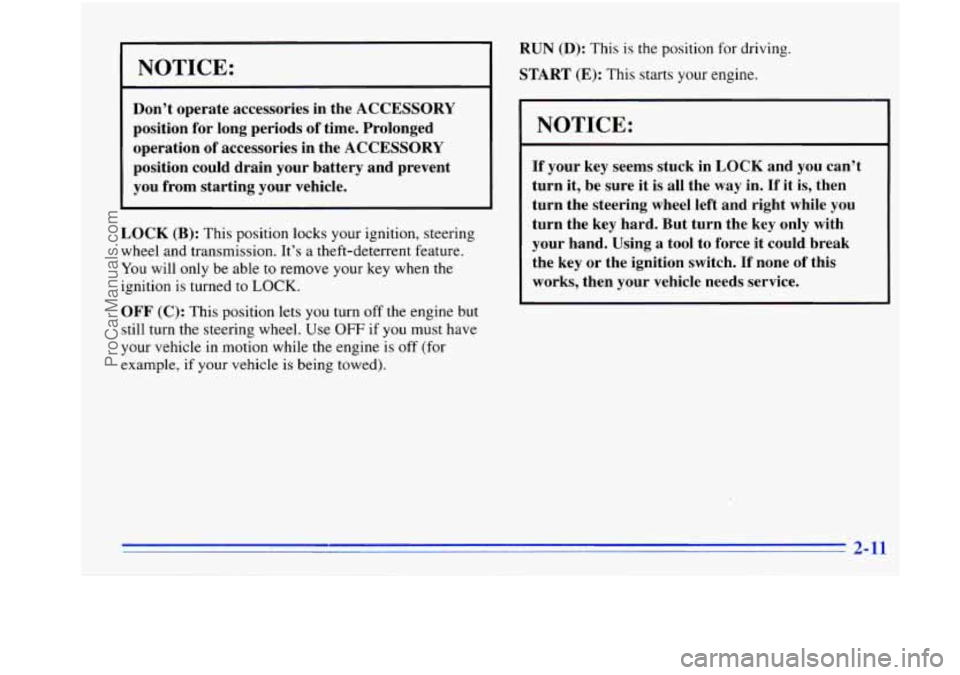
NOTICE:
Donât operate accessories in the ACCESSORY
position for long periods of time. Prolonged
operation of accessories in the ACCESSORY
position could drain your battery and prevent
you from starting your vehicle.
LOCK
(B): This position locks your ignition, steering
wheel and transmission. Itâs a theft-deterrent feature.
You will only be able to remove your key when the
ignition is turned to
LOCK.
RUN (D): This is the position for driving.
START (E): This starts your engine.
I NOTICE:
If your key seems stuck in LOCK and you canât
turn it, be sure it is all the way in.
If it is, then
turn the steering wheel left and right while you
turn the key hard. But turn the key only with
your hand. Using a tool to force it could break
the key or the ignition switch.
If none of this
1 works, then your vehicle needs service.
I
OFF (C): This position lets you turn off the engine but
still turn the steering wheel. Use
OFF if you must have
your vehicle in motion while the engine is
off (for
example, if your vehicle is being towed).
2-11
ProCarManuals.com
Page 64 of 340
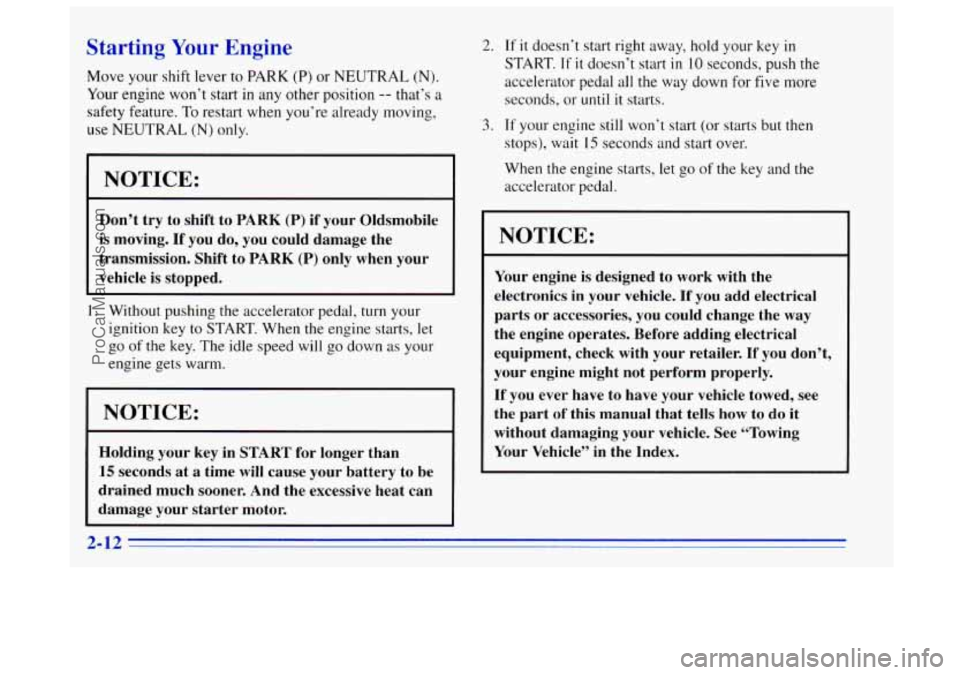
Starting Your Engine
Move your shift lever to PARK (P) or NEUTRAL (N).
Your engine wonât start in any other position -- thatâs a
safety feature. To restart when youâre already moving,
use NEUTRAL
(N) only.
I NOTICE:
Donât try to shift to PARK (P) if your Oldsmobile
is moving. If you do, you could damage the
transmission. Shift to PARK (P) only when your
vehicle is stopped.
1. Without pushing the accelerator pedal, turn your
ignition key
to START. When the engine starts, let
go
of the key. The idle speed will go down as your
engine gets warm.
I NOTICE:
Holding your key in START for longer than
15 seconds at a time will cause your battery to be
drained much sooner. And the excessive heat can
damage your starter motor.
2-:
2.
3.
If it doesnât start right away, hold your key in
START. If it doesnât start in 10 seconds, push the
accelerator pedal all the way down for five more
seconds, or until it starts.
If your engine still wonât start (or starts but then
stops), wait
15 seconds and start over.
When the engine starts, let go
of the key and the
accelerator pedal.
I NOTICE:
Your engine is designed to work with the
electronics in your vehicle.
If you add electrical
parts
or accessories, you could change the way
the engine operates. Before adding electrical
equipment, check with your retailer.
If you donât,
your engine might not perform properly.
If you ever have to have your vehicle towed, see
the part
of this manual that tells how to do it
without damaging your vehicle. See âTowing
Your Vehicleâ
in the Index.
ProCarManuals.com
Page 65 of 340

Engine Coolant Heater (Option)
The engine coolant heater
cord is secured on the
driverâs side of the vehicle,
by the brake controller.
In very cold weather,
0°F (- 18OC) or colder, the engine
coolant heater can help. Youâll get easier starting and
better fuel economy during engine warm-up. Usually,
the coolant heater should be plugged in
a minimum of
four hours prior to starting your vehicle.
To use the coolant heater:
1. Turn off the engine.
2. Open the hood and unwrap the electrical cord.
3. Plug it into a normal, grounded 110-volt AC outlet.
~ Plugging the cord into an ungrounded outlet
~ could cause an electrical shock. Also, the wrong
1 kind of extension cord could overheat and cause
~ a fire. You could be seriously injured. Plug the
~ cord into a properly grounded three-prong
110-volt AC outlet.
If the cord wonât reach, use a
heavy-duty three-prong extension cord rated for
at least 15 amps.
4. After youâve used the coolant heater, be sure to store
the cord as it was before
to keep it away from moving
engine parts.
If you donât, it could be damaged.
How long should you keep the coolant heater plugged
in? The answer depends on the outside temperature, the
kind
of oil you have, and some other things. Instead of
trying to list everything here, we ask that you contact
your Oldsmobile retailer in the area where youâll be
parking your vehicle. The retailer can give you the best
advice for that particular area.
ProCarManuals.com
Page 66 of 340
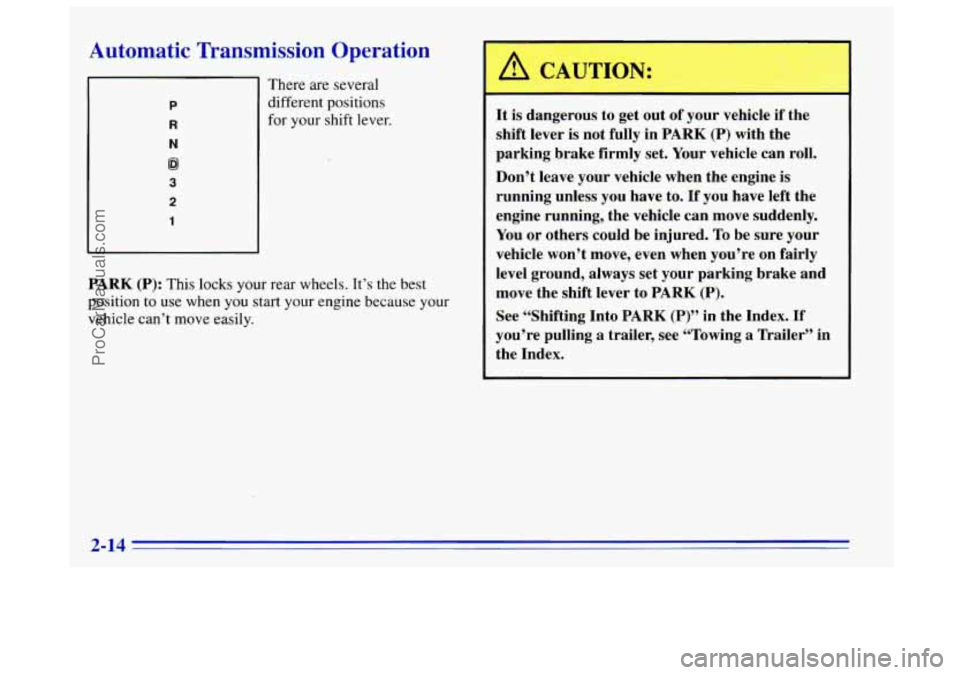
Automatic Transmission Operation
P
R
N
@I
3
2
1
There are several
different positions
for your shift lever.
PARK (P): This locks your rear wheels. Itâs the best
position
to use when you start your engine because your
vehicle canât move easily.
In CAUTION:
It is dangerous to get out of your vehicle if the
shift lever is not fully in
PARK (P) with the
parking brake firmly set. Your vehicle can roll.
Donât leave your vehicle when the engine is
running unless you have to.
If you have left the
engine running, the vehicle can move suddenly.
You or others could be injured. To be sure your
vehicle wonât move, even when youâre on fairly
level ground, always set your parking brake and
move the shift lever to
PARK (P).
See âShifting Into PARK (P)â in the Index. If
youâre pulling a trailer, see âTowing a Trailerâ in
the Index.
2-14
ProCarManuals.com
Page 67 of 340
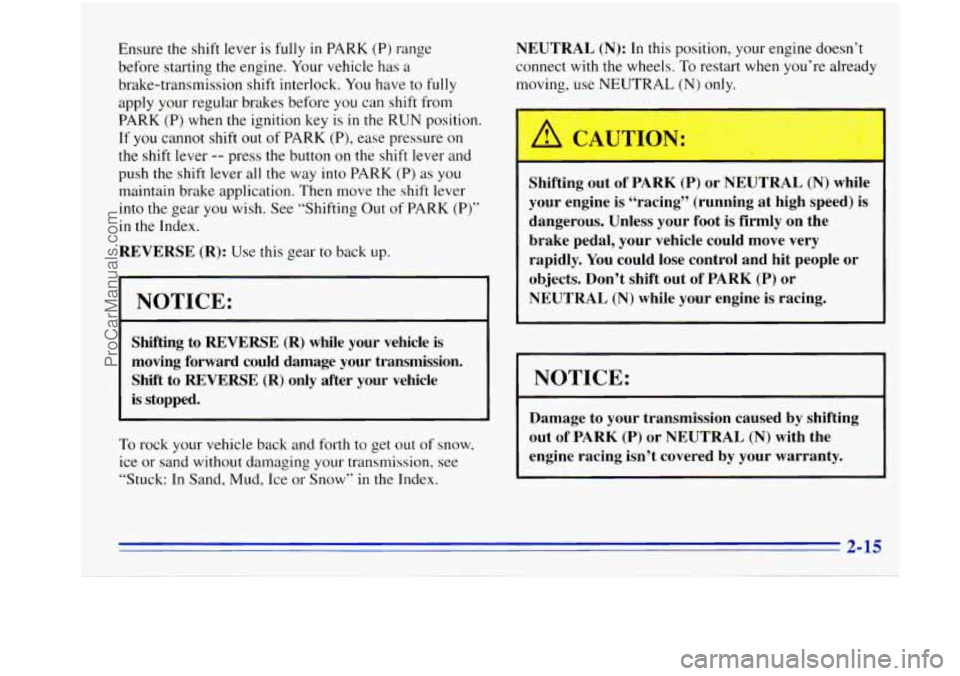
Ensure the shift lever is fully in PARK (P) range
before starting
the engine. Your vehicle has a
brake-transmission shift interlock. You have to fully
apply your regular brakes before you can shift from
PARK (P) when
the ignition key is in the RUN position.
If you cannot shift
out of PARK (P), ease pressure on
the shift lever -- press the button on the shift lever and
push the shift lever all the way into PARK
(P) as you
maintain brake application. Then move the shift lever
into the gear you wish. See âShifting Out of PARK
(P)â
in the Index.
REVERSE (R): Use this gear to back up.
I NOTICE:
Shifting to REVERSE (R) while your vehicle is
moving forward could damage your transmission.
Shift to REVERSE (R) only after your vehicle
is stopped.
To rock your vehicle back and forth to get out of snow,
ice
or sand without damaging your transmission, see
âStuck: In Sand, Mud, Ice or Snowâ in the Index.
NEUTRAL (N): In this position, your engine doesnât
connect with the wheels. To restart when youâre already
moving, use NEUTRAL
(N) only.
I
Shifting out of PARK (P) or NEUTRAL (N) while
your engine
is âracingâ (running at high speed) is
dangerous. Unless your foot is firmly on the
brake pedal,
your vehicle could move very
rapidly. You could lose control and hit people or
objects. Donât shift out
of PARK (P) or
NEUTRAL (N) while your engine is racing.
I NOTICE:
~~~
Damage to your transmission caused by shifting
out of PARK
(P) or NEUTRAL (N) with the
engine racing isnât covered by your warranty.
ProCarManuals.com
Page 68 of 340

AUTOMATIC OVERDRIVE (@): This position is for
normal driving. If
you need more power for passing,
and youâre:
Going less than about 35 mph (56 km/h), push your
accelerator pedal about halfway down.
Going about 35 mph (56 km/h) or more, push the
accelerator all the way down.
Youâll shift down to the next gear and have more power.
AUTOMATIC OVERDRIVE
(@) should not be used
when towing a trailer, carrying a heavy load, driving
on
steep hills or for off-road driving. Select THIRD (3) when
operating the vehicle under any
of these conditions.
THIRD (3): This position is also used for normal
driving, however it offers more power but lower fuel
economy than AUTOMATIC OVERDRIVE
((LO). You
should use THIRD
(3) when towing a trailer, carrying a
heavy load, driving on steep hills or winding roads or
for off-road driving.
SECOND (2): This position gives you more power but
lower
fuel economy. You can use SECOND (2) on hills.
It can help control your speed as you
go down steep
mountain roads, but
then you would also want to use
your brakes off and
on.
You can also use SECOND (2) for starting your vehicle
from a stop on slippery road surfaces.
FIRST (1): This position gives you even more power
(but lower
fuel economy) than SECOND (2). You can
use it on very steep hills,
or in deep snow or mud. If the
selector lever is put
in FIRST (1) while the vehicle is
moving forward, the transmission wonât shift into
FIRST (1) until the vehicle is going slowly enough.
I NOTICE:
If your rear wheels canât rotate, donât try to
drive. This might happen if you were stuck in
very deep sand or mud or were up against
a solid
object. You could damage your transmission.
Also, if you stop when going uphill, donât hold your
vehicle there with only the accelerator pedal. This
could overheat and damage the transmission. Use
your brakes or shift into PARK
(P) to hold your
vehicle in position on
a hill.
ProCarManuals.com
Page 69 of 340
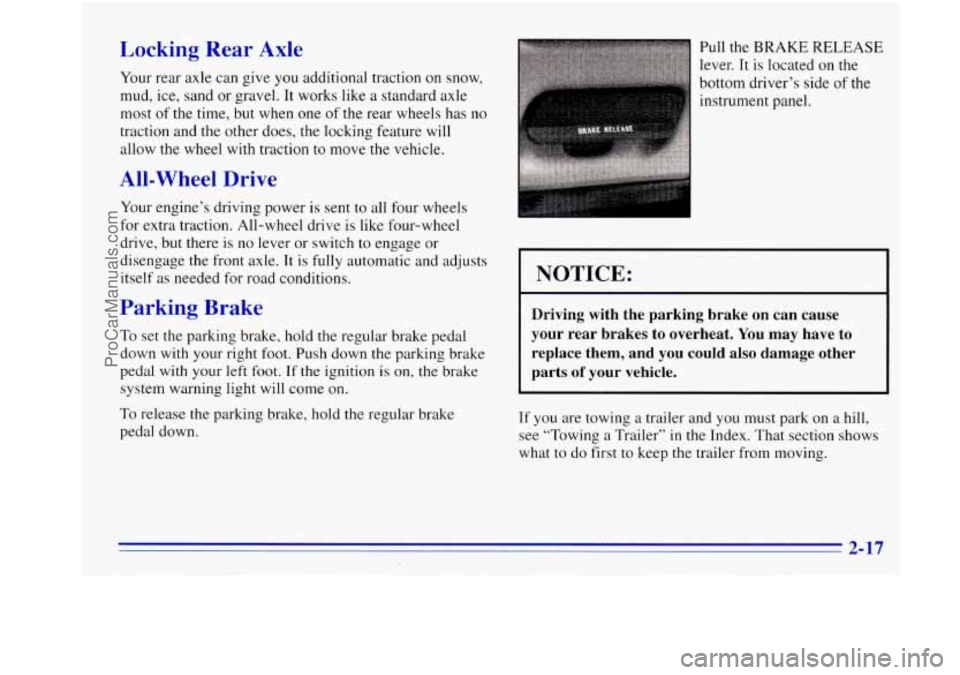
Locking Rear Axle
Your rear axle can give you additional traction on snow,
mud, ice, sand or gravel. It works like
a standard axle
most
of the time, but when one of the rear wheels has no
traction and the other does, the locking feature will
allow the wheel with traction to move the vehicle.
All-Wheel Drive
Your engineâs driving power is sent to all four wheels
for extra traction. All-wheel drive
is like four-wheel
drive, but there is no lever or switch
to engage or
disengage the front axle. It is
fully automatic and adjusts
itself
as needed for road conditions.
Parking Brake
To set the parking brake, hold the regular brake pedal
down with your right foot. Push down the parking brake
pedal with your left
foot. If the ignition is on, the brake
system warning light will come on.
To release the parking brake, hold the regular brake
pedal down. Pull the
BRAKE RELEASE
lever.
It is located on the
bottom driverâs side of the
instrument panel.
NOTICE:
Driving with the parking brake on can cause
your rear brakes to overheat. You may have to
replace them, and you could
also damage other
parts of your vehicle.
If you are towing a trailer and you must park on a hill,
see âTowing
a Trailerâ in the Index. That section shows
what to do first to keep the trailer from moving.
2-17
ProCarManuals.com
Page 70 of 340
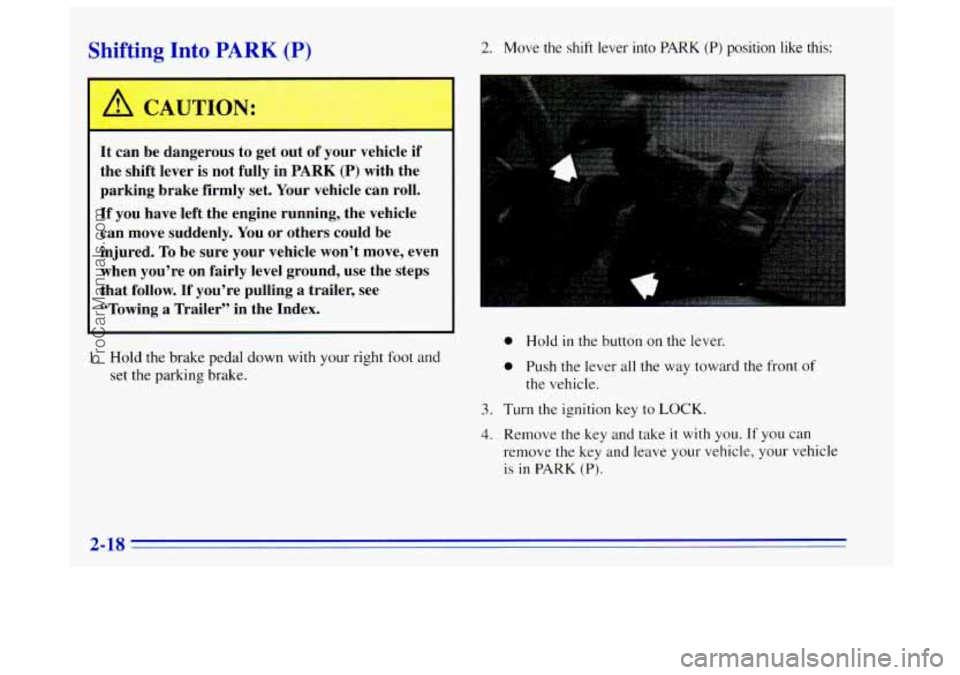
It can be dangerous to get out of your vehicle if
the shift lever is not fully in
PARK (P) with the
parking brake firmly set. Your vehicle can roll.
If you have left the engine running, the vehicle
can move suddenly. You
or others could be
injured.
To be sure your vehicle wonât move, even
when youâre on fairly level ground, use the steps
that follow.
If youâre pulling a trailer, see
âTowing
a Trailerââ in the Index.
1. Hold the brake pedal down with your right foot and
set the parking brake.
2. Move the shift lever into PARK (P) position like this:
0 Hold in the button on the lever.
0 Push the lever all the way toward the front of
the vehicle.
3. Turn the ignition key to LOCK.
4. Remove the key and take it with you. If you can
remove the key and leave your vehicle, your vehicle
is
in PARK (P).
2-18
ProCarManuals.com